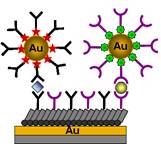Marc D. Porter
 ANALYTICAL CHEMISTRY
ANALYTICAL CHEMISTRY
USTAR Professor
B.S., Wright State University, 1977
Ph.D., The Ohio State University, 1984
NIH Postdoctoral Fellow, Bell Communications Research, 1984-1986
Phone: 801-587-1505
Office: 1320A HEB-N
Email: marc.porter@utah.edu
Activities & Awards
- Presidential Fellowship, The Ohio State U, 1983
- Dow Corning Assistant Professorship of Chemistry, Iowa State U, 1986-1989
- Society of Analytical Chemists of Pittsburgh New Faculty Award, 1987
- Alcoa Foundation Faculty Development Grant, 1991
- NSF Special Creativity Award, 1993
- Wright Brothers Award, Society of Aeronautical Engineers, 1993
- Analytical Chemistry, Editorial Advisory Board, 1996-9
- Electrochemistry Communications: Editorial Advisory Board, 1999-2007
- Langmuir Editorial Advisory Board, 1999-2002
- Summer Lecturer, Finland Academy of Sciences, 2000
- Liberal Arts & Sciences Mid-Career Award for Research/Artistic Creativity, Iowa State U, 2002
- McElvain Lecturer, University of Wisconsin-Madison, 2002
- R & D 100 Award, ERLsÔ (Extrinsic Raman Labels), 2003
- M. E. White Graduate Student Mentor Award, Iowa State U, 2004
- Wright State University Alumni Achievement Award, 2006
Research Interests
Our research aims at innovations central to the discovery and rapid screening of promising therapeutic compounds, nanomaterials, biomaterials, and biocatalysts. By creating high-throughput methods and miniaturizing analytical instrumentation, we are examining issues related, for example, to: (1) micro- and nanoelectronic and magnetic devices, (2) biosignatures for health and security, (3) chip-scale diagnostic platforms, and (4) chemical interaction databases.
These areas implicitly embody the ability to gain control over the chemistry and physics of liquid-solid interfaces. In our research we use an array of innovations in FTIR, STM, AFM, Raman spectroscopy, electrochemistry, fluorescence microscopy, acoustic wave techniques, and spectroelectrochemistry as ultra-sensitive tools for probing these relationships.

Detection and Sample Presentation in Diagnostics: Giant Magnetoresistors (GMRs). We have developed an ultra-sensitive assay platform based on magnetic techniques refined by the computer industry. Today’s hardrives have GMRs capable of reading nanometirc-sized bits at 300 Mb/s, translating to an extremely powerful means to read massively multiplexed sample arrays. Using a magnetic platform allows for straightforward incorporation of magnetic sample manipulation (i.e., label diverters), device actuation (i.e., magnetics-based pumps), detection, and readout for assays via microfluidic and conventional constructs.

Atomic Force Microscopy (AFM). AFM and its offshoots can map and manipulate surface composition at an atomic level. The nanometric resolution of these techniques makes visualization of surfaces modified with biological materials (e.g., DNA, viruses, bacteria) possible. We are also working to extend these remarkable tools to the diagnostics arena and to homeland security.

Surface Enhanced Raman Scattering (SERS). As a readout tool for biological assays, SERS has excellent limits of detection (attomolar levels), short read times. It also has strong multiplexed potential, because Raman bands are 10-100 times narrower than those for fluorescence. Moreover, today's SERS hardware is rugged, and can use a single excitation source to reqad multiple labels. To date we have demonstrated the efficacy of this strategy to detect low levels of cancer markers, biowarfare simulants, viruses, and bacteria.

Electrochemically Modulated Liquid Chromatography (EMLC). EMLC hybridizes liquid chromatography and electrochemistry by combining an electrochemical cell and a HPLC column. Using an applied potential to a conductive packing (e.g., porous graphitic carbon), chromatographic resolution and retention are manipulated by altering the donor-acceptor interactions between the packing and analytes. We have used this phenomenon to decrease separation times and alter retention order to a degree not attainable by conventional methods. Another attribute is the ability to determine physicochemical properties of analytes in a multiplexed fashion at electrified interfaces.

On-board Water Quality Monitoring for the Space Program: Colorimetric-Solid Phase Extraction (C-SPE). Spacecraft water quality is critical. In collaboration with scientists and engineers at NASA's Johnson Space Center, we are developing a microgravity-deployable instrument and test kits for the facile and rapid monitoring of biocide levels in the water storage and distribution systems on Shuttle, International Space Station, and beyond. C-SPE is the cornerstone of this project, and entails the spectrophotometric readout of an extraction disk impregnated with biocide-specific reagents. A light, commercially-available, hand-held diffuse reflectance spectrometer is used to analyze the color developed on the disk. The overall process requires only 45-90 s, and has been validated by microgravity-simulation flights.
Sept. 14, 2009 - The water quality monitoring method just started six months of tests aboard the International Space Station. Click here to read more about this project or here to see additional slides.
Marc Porter is a member of the Nano Institute of Utah.
Selected Publications
- G. Wang, J.D. Driskell, A.A. Hill, E.J. Dufek, R.J. Lipert, and M.D. Porter, "Rotationally-induced Hydrodynamics: Fundamentals and Applications to High Speed Bioassays", Ann. Rev. Anal. Chem., 2010, 3, 387-407.
- A. A. Hill, R. J. Lipert, and M. D. Porter, "Determination of Colloidal and Dissolved Silver in Water Samples Using Colorimeteric Solid Phase Extraction," Talanta, 2010, 80, 1606-1610.
- E.J. Dufek, M.D. Porter, "Competitive Surface-Enhanced Raman Scattering Assay for the 1,25-Dihydroxy Metabolite of Vitamin D3," Analyst, 2010, 135, 2811-2817.
- B. J. Yakes, D. W. Keller, and M. D. Porter, "Electrochemically Modulated Liquid Chromatographic Separation of Triazines and the Effect of pH on Retention," J. Chromatogr. A, 2010, 1217, 4395-4401.
- Y. Domi, K. Ikeura, K. Shimazu, and M. D. Porter, "Strong Inclusion of Inorganic Anions in beta-Cyclodextrin Monolayers Immobilized on Gold Electrodes," Langmuir, 2011, 27, 10580-10586.
- G. Wang, R.J. Lipert, M. Jain, S. Chakraboty, S. K. Batra, R. E. Brand, and M. D. Porter, "Detection of the Potential Cancer Marker MUC4 using Surface-Enhanced Raman Scattering," Anal. Chem., 2011, 83, 2554-2561.
- M. M. Bradley, L. M. Siperko, and M. D. Porter, "Colorimetric-Solid Phase Extraction Method for the Trace Level Determination of Arsenite in Water," Talanta, 2011, 77, 1405-1408.
- J. H. Granger, M. C. Granger, M. A. Firpo, S. J. Mulvihill and M. D. Porter, "Toward development of a surface-enhanced Raman scattering (SERS)-based cancer diagnostic immunoassay panel," Analyst, 2013, 138, 410- 416.
